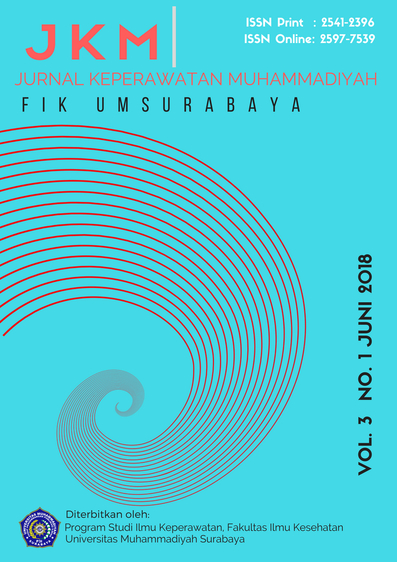Praktik Perawat Tentang Manajemen Nyeri Postoperasi Di Kabupaten Kebumen, Jawa Tengah Indonesia
DOI:
https://doi.org/10.30651/jkm.v3i1.1590Kata Kunci:
postoperative pain, management practice, nurses’ practiceAbstrak
Objective: this article was to describe nurses’ practice regarding postoperative pain management in Kebumen, Indonesia
Method: a descriptive survey design was used in this study. The sample consisted of 65 bachelor nurses who were working in the postoperative wards of five hospitals and selected by convenience sampling. However, only 63 nurses returned the questionnaires. The instrument in this study developed by the researcher and had passed reliability process by involved the five experts. The data collected from October to November 2015. Spearman’s correlation used to determine the correlations between demographic data with nurses’ practice.
Result: this study found that most of the subjects (66.7%) had a moderate level of practice (regarding postoperative pain management). There was no significantly between demographic data and practice. The others findings indicated that there was a significantly positive correlation between age and duration of working experience. On the other hand, there was a significantly negative correlation between duration of working experience and types of pain experienced by the nurse.
Conclusion: the nurses showed that had a moderate level of postoperative pain management.
Referensi
Mu Y, Edwards JR, Horan TC, Berrios-Torres SI, Fridkin SK. Improving risk-adjusted measures of surgical site infection for the national healthcare safety network. Infection Control and Hospital Epidemiology 2011; 32(10): 970–986. http://doi. org/10.1086/662016
Weitz DS, Geminiani A, Papadimitriou DEV, Ercoli C, Caton JG. The incidence of membrane perforation during sinus floor elevation using sonic instruments: a series of 40 cases. The International Journal of Periodontics & Restorative Dentistry 2014; 34(1): 105–112.
Gordon DB, Dahl JL, Miaskowski C, McCarberg B, Todd KH, Paice JA,Carr D B. American pain society recommendations for improving the quality of acute and cancer pain management: American Pain Society Quality of Care Task Force. Archives of Internal Medicine 2005; 165(14): 1574–1580. http://doi.org/10.1001/archinte.165.14.1574
McCaffery, Pasero C. Pain Control: Stigmatizing Patients as Addicts. The American Journal of Nursing 2001; 101(5): 77–81.
Ekman EF, Koman LA. Acute pain following musculoskeletal injuries and orthopaedic surgery: mechanisms and management. Instructional Course Lectures 2005; 54: 21–33.
Buckenmaier III, C. Blood-Stained Combat Boots and Acute Pain Medicine. Pain Medicine 2009; 10 (6): 957–958. http://doi.org/10.1111/j.1526-4637. 2009.00700_2.x
Chung JWY, Lui JCZ. Postoperative pain management: study of patients’ level of pain and satisfaction with health care providers’ responsiveness to their reports of pain. Nursing & Health Sciences 2003; 5 (1): 13–21.
Sherwood GD, McNeill JA, Starck PL, Disnard G. Changing acute pain management outcomes in surgical patients. AORN Journal 2003; 77(2): 374, 377–380: 384–390 passim.
Cadden KA. Better pain management. Nursing Management 2007; 38 (8): 30–35, NaN-36. http://doi.org/10.1097/01.NUMA.0000286188.21680.d3
_____, Pasero C, Ferrell BR. Nurses’ decisions about opioid dose. The American Journal of Nursing 2007; 107 (12): 35–39. http://doi.
Nasrullah, D., & Wibowo, N. A. (2016). EFEKTIFITAS TERAPI MUSCONG (MUSIK KERONCONG) UNTUK MENURUNKAN INTENSITAS NYERI PADA PASIEN ARTHITIS RHEMATHOID (STUDI KASUS PANTI WERDHA SURABAYA TIMUR). Jurnal Keperawatan Muhammadiyah, 1(2), 115-121.
Unduhan
Diterbitkan
Terbitan
Bagian
Lisensi
- Penulis tetap memegang hak atas karyanya dan memberikan hak publikasi pertama kepada jurnal ini yang secara simultan karya tersebut dilisensikan di bawah:Â Creative Commons Attribution-ShareAlike 4.0 International (CC BY-SA 4.0)









